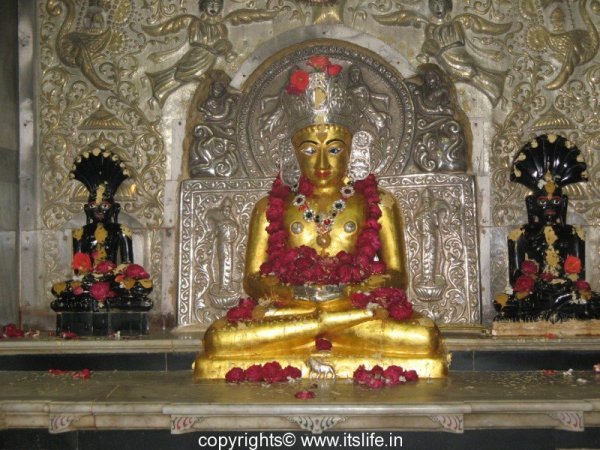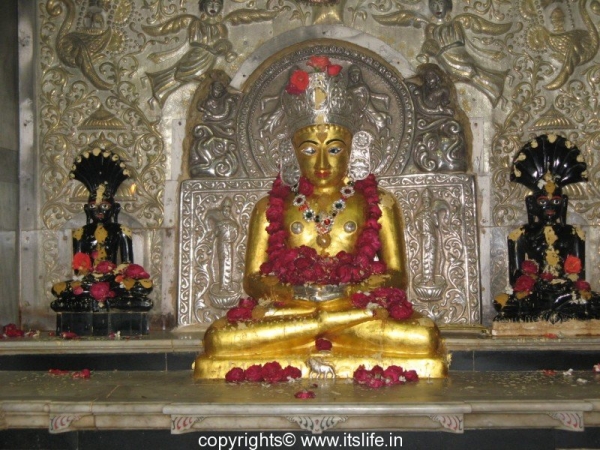Jainism
Diwali is celebrated by Jains with devotion, on this day Lord Mahavira the 24th Thirthankara achieved Nirvana on Amavasya of Ashvina masa in 527 B.C. The Lord left the body and achieved Mukti/liberation in Pavapuri, Bihar. Lighting of lamps on this day acknowledges Lord Mahavira’s preaching and knowledge.
Picture1 – Lord Mahavira
Jains fast on these three days and recite sacred hymns and meditate. They also listen to Uttaradhyavan Sutra, which is the final preaching of Lord Mahavira.
Houses will be elaborately and beautifully decorated with lamps and lights. They also worship Goddess Lakshmi on Amavasya and businessmen open new account. Sweets and savories are prepared and distributed to friends and relatives.
Sikhism
The third Sikh Guru Amar Das started Diwali celebrations my motivating all Sikhs to come together on this day and seek the blessings of the Guru at Goindwal. Another event that marks this festival is that the foundation stone of The Golden Temple at Amritsar was laid on Diwali.
Even though the Sikhs were celebrating Diwali since a long time, its significance increased historically when their revered Guru Hargobind Sahib was released from prison on this day at Gwalior. Hence, Diwali is celebrated as “Bandi Chhorh Diwas”/day of freedom by Sikhs. Emperor Jahangir imprisoned Guru Hargobind Sahib along with 52 other Hindu kings at Gwalior fort as political prisoners. The people pleaded for the release of their Guru and it was granted in October 1619. But, the Guru asked the emperor to release all the other kings along with him, to which he agreed. After the release, the Guru went straight to the Golden Temple at Amritsar and to welcome him there were hundreds of lamps lit in the temple.
During the festival people prepare sweets at home and devotees float multi-colored light candles on the water body around the Golden Temple. Here a grand fireworks display is held in the evening. Sikhs take out Nagar keertan/street procession during Diwali and Akhand paath or nonstop reading of Guru Granth Sahib is held as part of the celebrations. Joyful melas/fairs are also held.
Hinduism
Hindus celebrate Diwali for 5 days and they are as follows:
Day1 – (Ashwina Month / Tryodashi Day) – Dhanteras, Neeru thumbuva habba
Day2 – (Ashwina Month / Chathurdashi Day) – Narakachathurdashi, Choti Diwali
Day3 – (Ashwina Month / Amavasya Day) – Lakshmi Pooja, Amavasya
Day4 – (Karthika Month / Padya Day) – Balipadyami, Vikram Samvat(New Year), BaliPratipada
Day5 – (Karthika Month / Bidige – Dwithiya(2nd day of Karthika)) – Bhai Duj/Bhau Bij.
Picture2 – Flower Pot Cracker
Sindhi
Please note that Sindhis are also Hindus.
For Sindhis it is time for sweets, new clothes and family get together. They celebrate the home coming of Rama from his 14-year exile. Houses will get a fresh coat of paint and will be decorated with diya/lamps. Hatri, which is a miniature Pushpak Viman/a flying chariot that Lord Ram used to reach Ayodhya after defeating the 10-headed demon Ravan in Lanka is kept in the courtyard. The legend says that the chariot belonged to the God of wealth Kuber and was taken away by force by Ravan. After Ravan was killed, Vibheeshan the brother of Ravan was crowned the king of Lanka. Vibheeshan gave this chariot to Lord Ram for his return journey.
The miniature model of the hatri will be made up of clay and will be decorated with paper birds. Small idols of Ram, Laxman and Sita will be arranged inside it.
They also celebrate Narakachaturdashi, Bhai Duj, Lakshmi Pooja etc., just like Hindus.
Picture3 – Lakshmi Pooja
Buddhism
Buddhists especially Newar Buddhists celebrate Diwali in their quiet way. They chant the mantras and remember Emperor Ashoka who converted to Buddhism on this day. Hence the Buddhists also know the festival as Ashok Vijayadashami. Their temples and monasteries are well decorated during this time and the Buddha is worshiped with full honors.
Picture4 – Buddhist Monastery
For festival food recipes click here.
For festival snacks and drinks recipes click here.



